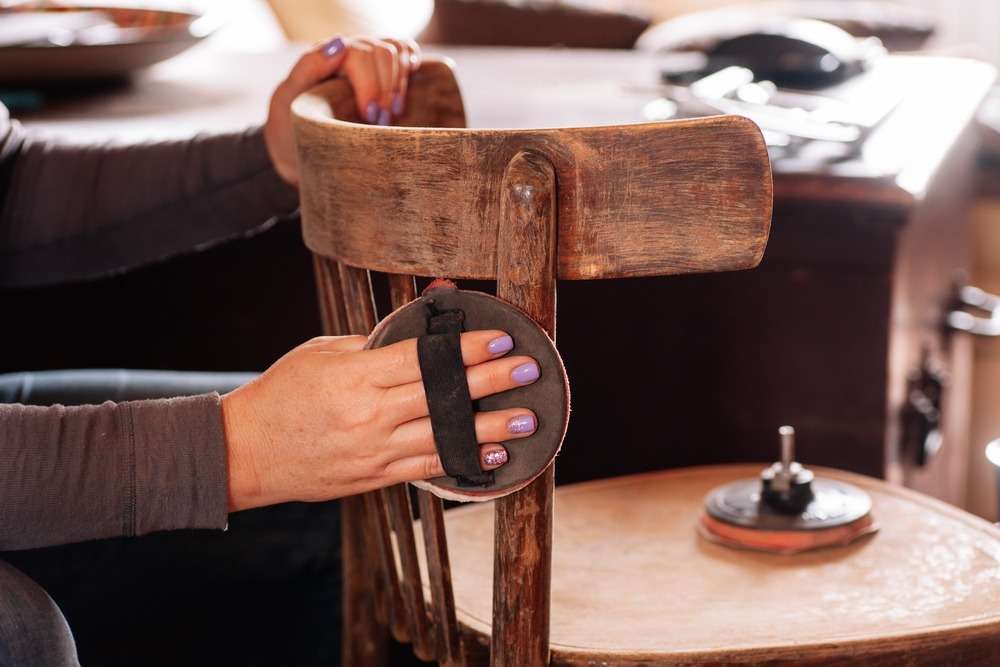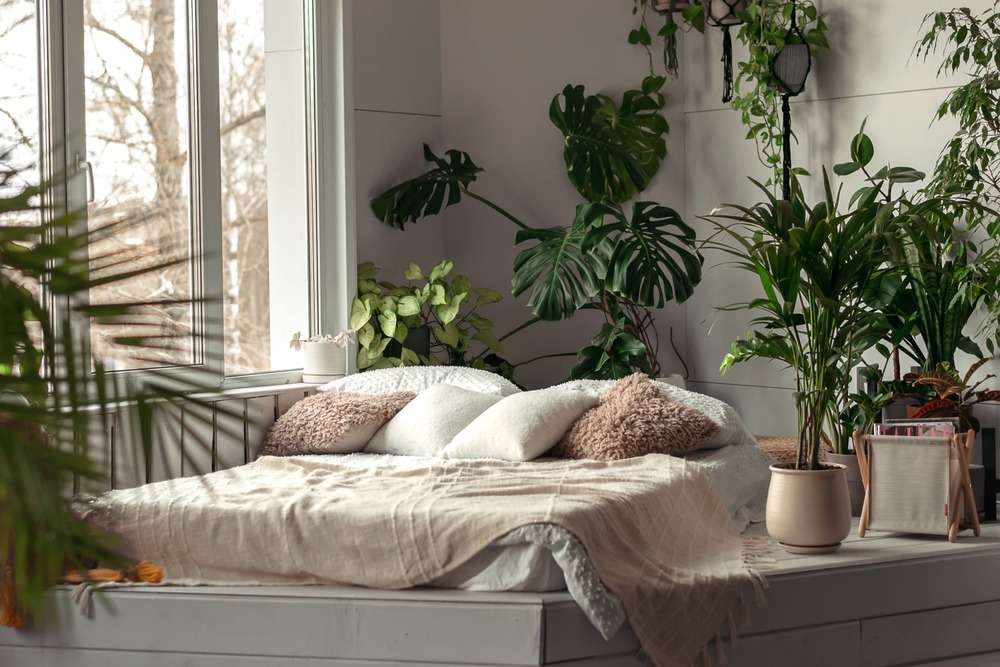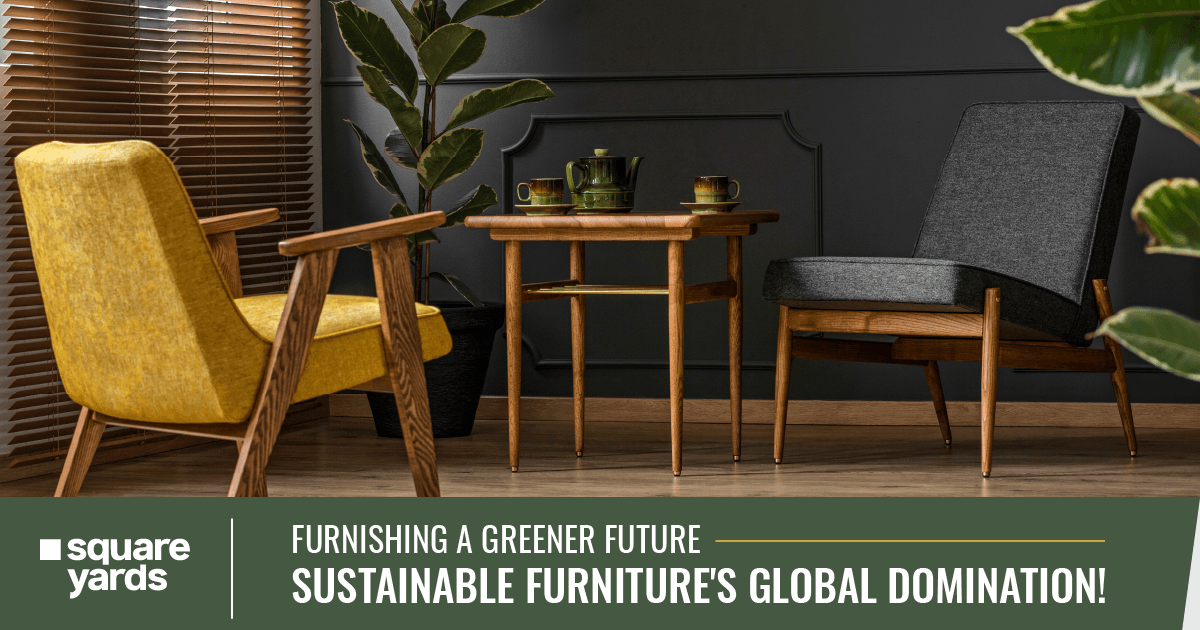We are slowly stepping into a world where sustainability meets style, where furniture enhances your living space and contributes to a greener future. We will soon welcome an unstoppable rise of sustainable furniture, the latest trend taking the world by storm. From eco-friendly materials to innovative designs, this revolution in home décor is rewriting interior design rules. Gone are the days of sacrificing style for sustainability. Today, sustainable furniture combines elegance and functionality with a conscious environmental commitment. It embraces the principles of reducing waste, using renewable resources, and minimising the carbon footprint without compromising aesthetics.
So, my fellow environmentalists, buckle up for a world where sustainable furniture is revolutionising design, transcending boundaries, and rewriting the design rulebook. Embark on a captivating journey as we embrace a greener future, adorning our spaces with extraordinary pieces that embody both elegance and ecological responsibility. It’s time we go for a greener future and furnish our homes with fabulous pieces and heroes in disguise.
Table of contents
- Eco-Friendly Furniture Delights: Unveiling the Beauty of Sustainable Furnishings
- From Trash to Treasure: The Art of Upcycled Furniture
- Eco-Friendly Materials: Exploring Nature’s Finest for Your Home
- Conscious Consumption: Making Ethical Choices with Green Furniture
- Conclusion: Infusing Your Lifestyle with Eco-Friendly Furniture
Eco-Friendly Furniture Delights: Unveiling the Beauty of Sustainable Furnishings
As the world shifts slowly towards a reality where aesthetics embraces sustainability, a wondrous tapestry of eco-friendly furniture unfolds, unveiling the beauty of sustainable furnishings. Each piece tells a story, intricately crafted from reclaimed wood, recycled materials, or responsibly sourced elements. From captivating chairs adorned with upcycled fabrics to mesmerising tables sculpted from salvaged treasures, these creations are more than mere decor; they are reflections of conscious living and inspired design. As we invite these eco-chic delights into our spaces, we adorn our surroundings with enchanting elegance and embrace a profound connection with nature. Experience a captivating fusion of style and sustainability as you enter a world where extraordinary transformations unfold.
Sustainability Spotlight: Inspiring Stories of Green Interior Design
India is making incredible strides in the realm of sustainable furniture, blending traditional craftsmanship with eco-conscious practices. From embracing renewable materials to promoting ethical manufacturing, the country is fostering a growing market of green furnishings, contributing to a more sustainable future for all. Some Indian furniture brands are contributing immensely towards sustainable furniture.
Sirohi
Founded in 2012 in the serene village of Sirohi, nestled among the scenic Aravali hills in rural Haryana, Sirohi is a remarkable enterprise embodying sustainability. Empowering over 200 women, the company crafts exquisite, high-quality, eco-friendly home decor, leveraging local expertise. Through upcycling textile waste and plastic, Sirohi fuels a circular economy, using natural fabrics like cotton and jute. With a focus on heritage-infused modern designs, the company embraces a straightforward and sustainable manufacturing process. By supporting local artisans and providing them with essential tools, Sirohi creates practical products while fostering financial Independence within the community.
Econiture
Econiture, an innovative sustainable furniture brand based in India, takes pride in repurposing discarded items destined for landfills. Using 100% recycled plastic, they craft a diverse range of benches, chairs, stools, racks, and furniture sets. Each meticulously designed piece is built to endure, offering functionality and contributing to waste diversion from landfills and oceans. Econiture’s commitment to creating one-of-a-kind furniture helps reduce the consumption of new resources while simultaneously addressing the pressing issue of dry waste. Through their circular approach, they inspire a greener future and promote the value of sustainability in the furniture industry.
Sadaya Guild
Sadaya Guild is dedicated to crafting exquisite furniture using the finest materials available. What sets them apart is their commitment to sourcing wood from post-consumer waste, fostering a circular economy. To minimise their carbon footprint, they repurpose packaging materials from neighbouring industries, diverting waste from landfills. The company upholds a disciplined work culture, emphasising established systems to improve quality and efficiency. Focusing on excellent craftsmanship, they create products using sustainable and repurposed materials. The reused wood enhances stability and durability and matures into beautiful pieces. Sadaya Guild strives to merge innovation with established practices, delivering perfection in every creation.
Eco Deco
Eco Deco is dedicated to establishing a circular economy and sustainable recycling infrastructure, working closely with ragpickers to reduce plastic waste. Their mission focuses on minimising the use of virgin plastic by incorporating eco-boards and reducing unnecessary wood consumption to combat deforestation. Every product offered by Eco Deco is crafted from 100% recycled plastic. The workforce, including partners, upholds sustainability values, ensuring a minimal carbon footprint throughout the supply chain. Solid wood, recycled from various post-consumer sources, forms the foundation of their furniture, providing a mature, rustic, and natural aesthetic. Each piece is uniquely handcrafted, designed to harmonise with the wood’s texture, creating truly one-of-a-kind furniture.
The Second Wind
The Second Wind, a design studio situated in Gurugram, skillfully blends vintage charm with modernity. They transform objects into furniture through renovation and rejuvenation, seamlessly integrating old and new designs while upcycling and repurposing materials. With a dedicated workforce, The Second Wind crafts stunning, eco-friendly home decor, showcasing their passion for thoughtful and utility-driven creations. Led by Ira Maurya and Abhinav Mehta, the brand offers a unique range of restored products, upcycled furniture, and rare home accessories that are hard to find elsewhere. Their commitment to sustainability shines through their use of discarded materials, redirecting them from landfills and giving them new life through upcycling.
From Trash to Treasure: The Art of Upcycled Furniture
Trash to Treasure refers to transforming discarded or unwanted items into valuable or desirable objects through creative repurposing, upcycling, or recycling. Instead of simply discarding these items as waste, they are given a new lease on life by turning them into unique, functional, and aesthetically pleasing products. The concept embodies the principles of sustainability, resourcefulness, and environmental consciousness. Here’s a detailed breakdown of the key aspects of Trash to Treasure:
Repurposing and Upcycling
- Repurposing involves finding alternative uses for items originally intended for a different purpose.
- Upcycling involves taking an item and upgrading or transforming it into something of higher value or quality.
Creative Design and Innovation
- Trash to Treasure encourages innovative thinking and creative design approaches to reimagine the potential of discarded items.
- Designers and artisans often employ their creativity to give new life to materials and objects that would otherwise end up in landfills.
Environmental Benefits
- Trash to Treasure initiatives reduces the amount of waste sent to landfills, mitigating the environmental impact of waste disposal.
- The need for new resources and energy-intensive production processes is minimised by repurposing or upcycling materials, decreasing carbon emissions and resource consumption.
Unique and Customised Products
- One of the main appeals of trash to treasure is the creation of one-of-a-kind products with character and history.
- Each repurposed item tells a story and possesses a unique aesthetic, making it a valuable and personalised addition to homes or spaces.
Promoting Sustainability and Conscious Consumption
- Trash to Treasure aligns with sustainability principles by encouraging mindful consumption and reducing the demand for new products.
- It promotes a shift towards a circular economy, where materials and resources are reused and recycled, minimising waste generation.
Social and Economic Impact
- Trash to Treasure initiatives can allow local artisans, entrepreneurs, and communities to showcase their creativity and skills.
- It can contribute to local economies, job creation, and empowerment by utilising existing resources and engaging in sustainable practices.
- Trash to Treasure represents a transformative approach to waste, turning discarded items into valuable and purposeful creations. It embodies the spirit of sustainability, creativity, and responsible consumption, inspiring individuals and communities to rethink their relationship with waste and embrace a more environmentally conscious lifestyle.

Eco-Friendly Materials: Exploring Nature’s Finest for Your Home
Regarding furnishing your home eco-friendly, various materials are available that minimise environmental impact and promote sustainability. These materials offer an excellent alternative to conventional options, reducing resource consumption, minimising waste, and supporting a greener lifestyle. Here are some eco-friendly materials commonly used for making furniture.
FSC-Certified Wood
- Wood sourced from responsibly managed forests certified by the Forest Stewardship Council (FSC) ensures sustainable harvesting practices.
- Look for furniture made from FSC-certified hardwoods such as oak, maple, or bamboo, which are durable and renewable.
Bamboo
- A fast-growing grass, bamboo is a popular eco-friendly choice due to its rapid regrowth and minimal environmental impact.
- It is incredibly strong, making it suitable for various furniture applications, including chairs, tables, and flooring.
Reclaimed Wood
- Salvaged or reclaimed wood repurposed timber from old buildings, barns, or industrial structures, reducing the need for new lumber.
- Each piece carries a unique history and character, making reclaimed wood furniture sustainable and aesthetically appealing.
Recycled Plastic
- Furniture made from recycled plastic contributes to waste reduction and conserves energy and resources.
- Plastic waste, such as discarded bottles or packaging, can be transformed into durable outdoor furniture, chairs, and tables.
Natural Fiber and Organic Fabrics
- Natural fibres like organic cotton, linen, jute, or hemp are renewable, biodegradable, and chemical-free options for upholstery and textiles.
- These materials provide a healthier indoor environment and reduce the ecological footprint associated with synthetic fabrics.
Cork
- Derived from the bark of oak trees, cork is a sustainable resource for producing various furniture elements, including tabletops and drawer liners.
- The tree is not cut down during harvesting, allowing it to grow and absorb carbon dioxide.
Recycled or Upcycled Materials
- Furniture crafted from recycled or upcycled materials, such as salvaged metals or repurposed industrial objects, helps divert waste from landfills.
- These unique pieces can be creatively designed, offering a second life to discarded items.
Low-VOC Finishes
- Look for furniture finished with low-VOC (Volatile Organic Compounds) or water-based finishes to minimise indoor air pollution and toxic emissions.
Choosing furniture made from these eco-friendly materials reduces your carbon footprint and contributes to a more sustainable and environmentally conscious home. Embracing nature’s finest options for furniture not only adds beauty and style to your space but also aligns with a responsible and eco-friendly lifestyle.
Conscious Consumption: Making Ethical Choices with Green Furniture
In today’s world, adopting a mindset of conscious consumption is essential for promoting sustainability and making ethical choices. Green furniture lets you align your values with purchasing decisions when furnishing your home. Here are some key points to consider when practising conscious consumption of green furniture.
Sustainable Materials
- Choose furniture made from sustainable materials such as FSC-certified wood, bamboo, or reclaimed wood, which minimise deforestation and supports responsible sourcing practices.
- Look for certifications like Cradle to Cradle or B Corp to ensure the furniture is produced with a focus on sustainability and ethical manufacturing.
Non-Toxic and Low VOCs
- Opt for furniture free from harmful chemicals and toxins, reducing indoor air pollution and promoting a healthier living environment.
- Look for low VOC (Volatile Organic Compounds) or water-based finishes, adhesives, and paints with fewer harmful emissions.
Ethical Production
- Choose brands that prioritise fair trade practices, ensuring that workers in the manufacturing process are treated fairly and receive fair wages.
- To uphold ethical production standards, look for certifications like Fair Trade or Social Accountability International (SAI).
Minimal Waste and Packaging
- Consider furniture that is designed to minimise waste during production and packaging.
- Look for brands that use recycled or recyclable packaging materials and employ efficient manufacturing processes to reduce waste generation.
Durability and Longevity
- Select furniture built to last and withstand the test of time, reducing the need for frequent replacements and the associated resource consumption.
- High-quality craftsmanship and durable materials contribute to furniture longevity, making it a more sustainable choice in the long run.
Secondhand and Vintage
- Embrace the beauty of second-hand and vintage furniture, which adds character and uniqueness to your space and reduces the demand for new production.
- Explore thrift stores, consignment shops, online marketplaces, and antique fairs to find hidden treasures that can be given new life in your home.
Consider Lifecycle and End-of-Life Disposal
- Think about the entire lifecycle of the furniture, from production to disposal.
- Choose furniture that can be easily repaired, refurbished, or recycled at the end of its life, reducing waste sent to landfills.
Local and Artisanal
- Support local artisans and craftsmen who create furniture using sustainable practices and materials.
- Local sourcing minimises transportation emissions and promotes the growth of local economies.
Making conscious choices with green furniture contributes to a more sustainable and ethical world. Each purchase becomes an opportunity to support responsible manufacturing, reduce waste, and create a positive impact on the environment and communities. With conscious consumption, your furniture choices reflect your values and are a step towards a greener future.

Conclusion: Infusing Your Lifestyle with Eco-Friendly Furniture
The rising global awareness of our environmental impact has fueled a demand for sustainable furniture that reflects personal style and eco-conscious values. Using innovative techniques and materials like reclaimed wood, recycled plastics, and organic textiles, sustainable furniture has become a powerful force, permeating homes, offices, and public spaces worldwide. By choosing these conscientiously crafted pieces, we actively contribute to a greener world, reducing waste and minimising environmental impact while expressing individuality. Let us embrace this transformative shift and inspire others to join the global movement toward a greener, more sustainable future.





































